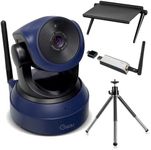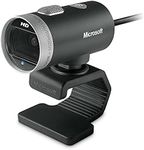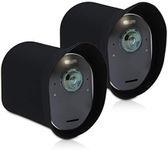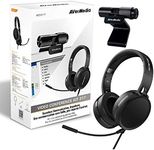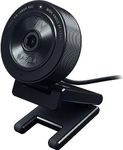Buying Guide for the Best Wireless Webcams
Choosing a wireless webcam can make video calls, streaming, and recording much more convenient by eliminating the need for cables and allowing flexible placement. To find the best fit, it's important to understand the main features that affect performance and usability. Think about how and where you'll use the webcam—whether for work meetings, online classes, content creation, or casual chats. Knowing your needs will help you focus on the specs that matter most for your situation.ResolutionResolution refers to the clarity and detail of the video the webcam can capture, usually measured in pixels such as 720p (HD), 1080p (Full HD), or 4K (Ultra HD). Higher resolution means a sharper and clearer image, which is important if you want your video to look professional or if you plan to use the webcam for streaming or recording. For basic video calls, 720p is usually enough, but for more detailed work or content creation, 1080p or higher is better. Consider what you’ll use the webcam for—if you just need to be seen clearly in meetings, lower resolution is fine, but for high-quality video, go for higher resolution.
Frame RateFrame rate is the number of images the webcam captures per second, measured in frames per second (fps). A higher frame rate, like 60fps, results in smoother video, which is great for streaming or recording fast movements. Most webcams offer 30fps, which is good for regular video calls. If you want your video to look very smooth, especially for gaming or action, look for higher frame rates. For everyday use, 30fps is usually enough, but if you want extra smoothness, consider 60fps.
Wireless ConnectivityWireless webcams connect to your computer or device using Wi-Fi or Bluetooth instead of cables. The type of wireless connection affects how stable and fast the video stream is. Wi-Fi generally offers better range and stability, making it suitable for longer distances or moving the webcam around a room. Bluetooth is more limited in range and speed, so it's best for close-range use. Think about where you’ll place the webcam and how far it will be from your computer—choose Wi-Fi for more flexibility, or Bluetooth for simple, nearby setups.
Microphone QualityMany wireless webcams come with built-in microphones, which capture your voice during calls or recordings. The quality of the microphone affects how clear and natural you sound. Some webcams have basic microphones that are fine for casual chats, while others offer noise-cancelling features for clearer audio in noisy environments. If you plan to use the webcam for important meetings or content creation, look for one with a high-quality or dual microphone setup. For occasional use, a basic microphone may be enough.
Field of ViewField of view (FOV) describes how much of the scene the webcam can capture, measured in degrees. A wider FOV (like 90 degrees or more) can show more of your surroundings, which is useful for group calls or showing more of your workspace. A narrower FOV (around 60-70 degrees) focuses more on your face, which is better for solo calls. Decide if you want to show just yourself or include more of your environment, and pick the FOV that matches your needs.
Mounting OptionsMounting options refer to how and where you can place the webcam. Some webcams have clips for attaching to a monitor or laptop, while others have stands or can be mounted on a tripod. Flexible mounting is important if you want to use the webcam in different locations or angles. Think about where you’ll use the webcam most often and make sure it can be easily and securely placed there.
Battery LifeSince wireless webcams run on batteries, battery life determines how long you can use the webcam before needing to recharge. Longer battery life is important if you plan to use the webcam for extended periods or in places where charging is inconvenient. If you only use the webcam for short calls, battery life may not be as critical. Consider how long your typical sessions are and choose a webcam with enough battery life to cover your needs.
CompatibilityCompatibility means whether the webcam works with your computer, operating system, or other devices. Some webcams are designed for specific platforms, while others are more universal. Make sure the webcam supports your device and the software you plan to use, such as video conferencing apps or streaming platforms. Check for plug-and-play features if you want an easy setup.


